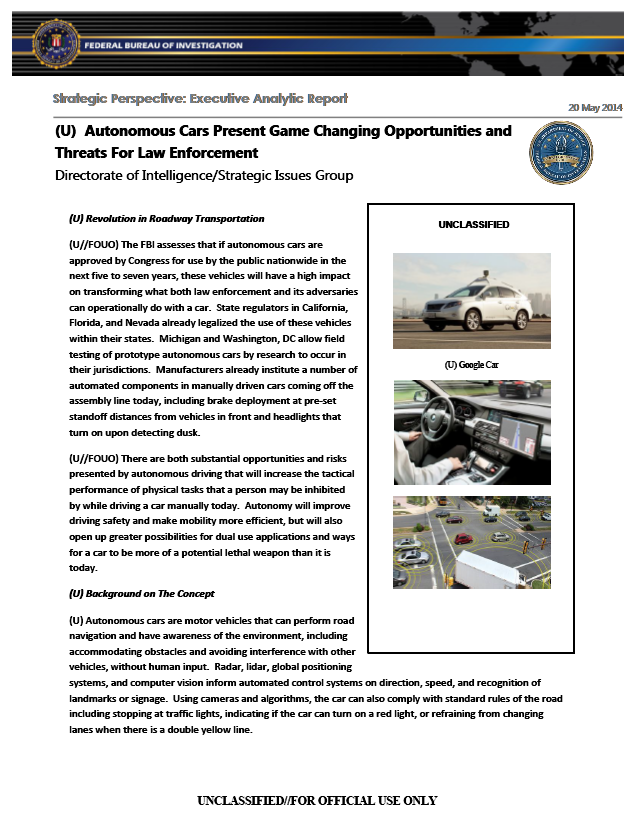The following document was obtained by journalist Mark Harris as part of a public records request to a state Department of Motor Vehicles. For more information on the report, see his article for the Guardian “FBI warns driverless cars could be used as ‘lethal weapons’“.
Autonomous Cars Present Game Changing Opportunities and Threats For Law Enforcement
- 2 pages
- For Official Use Only
- May 20, 2014
(U//FOUO) The FBI assesses that if autonomous cars are approved by Congress for use by the public nationwide in the next five to seven years, these vehicles will have a high impact on transforming what both law enforcement and its adversaries can operationally do with a car. State regulators in California, Florida, and Nevada already legalized the use of these vehicles within their states. Michigan and Washington, DC allow field testing of prototype autonomous cars by research to occur in their jurisdictions. Manufacturers already institute a number of automated components in manually driven cars coming off the assembly line today, including brake deployment at pre-set standoff distances from vehicles in front and headlights that turn on upon detecting dusk.
(U//FOUO) There are both substantial opportunities and risks presented by autonomous driving that will increase the tactical performance of physical tasks that a person may be inhibited by while driving a car manually today. Autonomy will improve driving safety and make mobility more efficient, but will also open up greater possibilities for dual use applications and ways for a car to be more of a potential lethal weapon than it is today.
(U) Background on The Concept
(U) Autonomous cars are motor vehicles that can perform road navigation and have awareness of the environment, including accommodating obstacles and avoiding interference with other vehicles, without human input. Radar, lidar, global positioning systems, and computer vision inform automated control systems on direction, speed, and recognition of landmarks or signage. Using cameras and algorithms, the car can also comply with standard rules of the road including stopping at traffic lights, indicating if the car can turn on a red light, or refraining from changing lanes when there is a double yellow line.
(U) Opportunities for Increased Operational Capability for Both Blue Forces and Adversaries
(U//FOUO) US law enforcement can capitalize on numerous benefits of autonomous cars.
(U//FOUO) Multitasking: Law enforcement officers and bad actors will both be able to conduct tasks that require use of both hands or take one’s eyes off the road which would be impossible to conduct simultaneously today while driving a car manually. The risk that distraction or poor judgment leading to collision that stems from manual operation would be substantially reduced. While autonomous cars would likely face many hardships with evasive driving or car chases, these cars can optimize the best way to perform, say a “K turn”, or other awkward maneuvers that could cause responders to lose time in pursuit of a suspect or getting to a scene in a timely fashion.
(U//FOUO) Surveillance: With the lidar and laser sight lines combined with GPS tracking, surveillance will also be made more effective and easier, with less of a chance that a patrol car will lose sight of a target vehicle unlike the human eye. In addition, algorithms can control the distance that the patrol car is behind the target to avoid detection or intentionally have a patrol car make opposite turns from that which the target makes at intersections yet successfully meet up at later points with the target.
(U//FOUO) Implications for First Responders
(U//FOUO) Autonomous vehicle technology will not only impact law enforcement, it will impact the first responder community. Potential issues for consideration include:
(U//FOUO) The requisite time commitment to research and plan for the deployment of autonomous vehicles (various applications of technology, the need for enhanced security measures, etc.).
(U//FOUO) The impact on organizational budgets (e.g., acquisition costs, implementation of new training programs, execution of new rapid response policies and procedures).
(U//FOUO) The effect on daily emergency response capabilities.
(U//FOUO) The necessity of staying current on autonomous vehicle-related infrastructure and potential security vulnerabilities.

